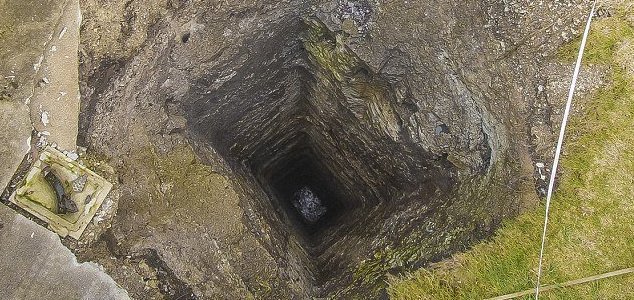Shaft mining or shaft sinking refers to the method of excavating a vertical or near-vertical tunnel from the top down, where there is initially no access to the bottom.
Shaft sinking refers to the general activity, however shallow shafts, typically sunk for civil engineering projects differ greatly in execution method from deep shafts, typically sunk for mining projects. When the top of the excavation is the ground surface, it is referred to as a shaft; when the top of the excavation is underground, it is called a winze or a sub-shaft. Small shafts may be excavated upwards from within an existing mine as long as there is access at the bottom, in which case they are called Raises. A shaft may be either vertical or inclined (between 45 and 90 degrees to the horizontal), although most modern mine shafts are vertical.
If access exists at the bottom of the proposed shaft and ground conditions allow then raise boring may be used to excavate the shaft from the bottom up, such shafts are called borehole shafts. Shaft Sinking is one of the most difficult of all development methods: restricted space, gravity, groundwater and specialized procedures make the task quite formidable.
Historically mine shaft sinking has been among the most dangerous of all mining occupations and the preserve of mining contractors. Today shaft sinking contractors are concentrated in Canada and South Africa.

It is unclear how deep the water at the bottom of the hole is.
The deadly drop opened up in the back garden of an unoccupied bungalow while it was being surveyed.
Estimated to be at least 300ft deep, the huge hole was once part of an 18th century tin mine and opened up unexpectedly while surveyors were checking the property for ground stability.
“There was nothing there at all that shows there was a shaft,” said Stuart Dann of Mining Eye.
“Both houses nearby are empty, which is a very good job. It is easy to see the woods, fields and houses and assume nothing was there. If you go back to 1750, the area was completely different.”
Local man Mark Thomas, who managed to capture some impressive aerial video footage of the mineshaft using a remote-controlled drone (below), described the hole as “truly massive.”
“It’s approximately 300 feet to water and god knows how deep from there,” he said.













